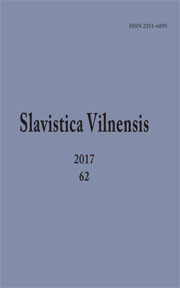Речь Посполитая (Польша, Русь и Литва) как Святая Троица: средневековая предыстория поэтического образа Платона Костецкого (1861)
Poland, Ruthenia and Lithuania as the Holy Trinity: A Medieval Prehistory of the Poetic Image by Platon Kostec’kyj (1861)
Author(s): Sergey Yurievich TemchinSubject(s): Bulgarian Literature, 19th Century, Theory of Literature
Published by: Vilniaus Universiteto Leidykla
Keywords: Platon Kostec’kyj; Ukrainian poetry; Jagiellonian idea; Polish-Lithuanian Commonwealth; Cyrillic literacy; Old Bulgarian literature; apocrypha; Trinity;
Summary/Abstract: This paper focuses on a medieval parallel with the poetic image of Poland, Ruthenia and Lithuania as the Holy Trinity presented in the poem Nasza mołytwa (1861) composed in Ukrainian, although written in Polish script by the Galician journalist and writer Platon Kostec’kyj who was an adherent of the Jagiellonian idea. The parallel can be found in the Old Bulgarian apocryphal treatise Razumnik Ukaz. Its two versions have been preserved in Cyrillic manuscripts of the second half of the 14th through the mid-18th centuries. The corresponding passages of the two version are cited in the article in order to demonstrate that the second version coincides in some respects with the poetic image by Platon Kostec’kyj. It is quite possible that the author, who had been born to a family of a priest of the Eastern-rite Catholic Church, may have known the second version of Razumnik Ukaz and later used its ideas while compiling his poem Nasza mołytwa. This medieval parallel is useful for explaining the poetic image created in 1861.
Journal: Slavistica Vilnensis
- Issue Year: 62/2017
- Issue No: -
- Page Range: 265-275
- Page Count: 11
- Language: Russian

